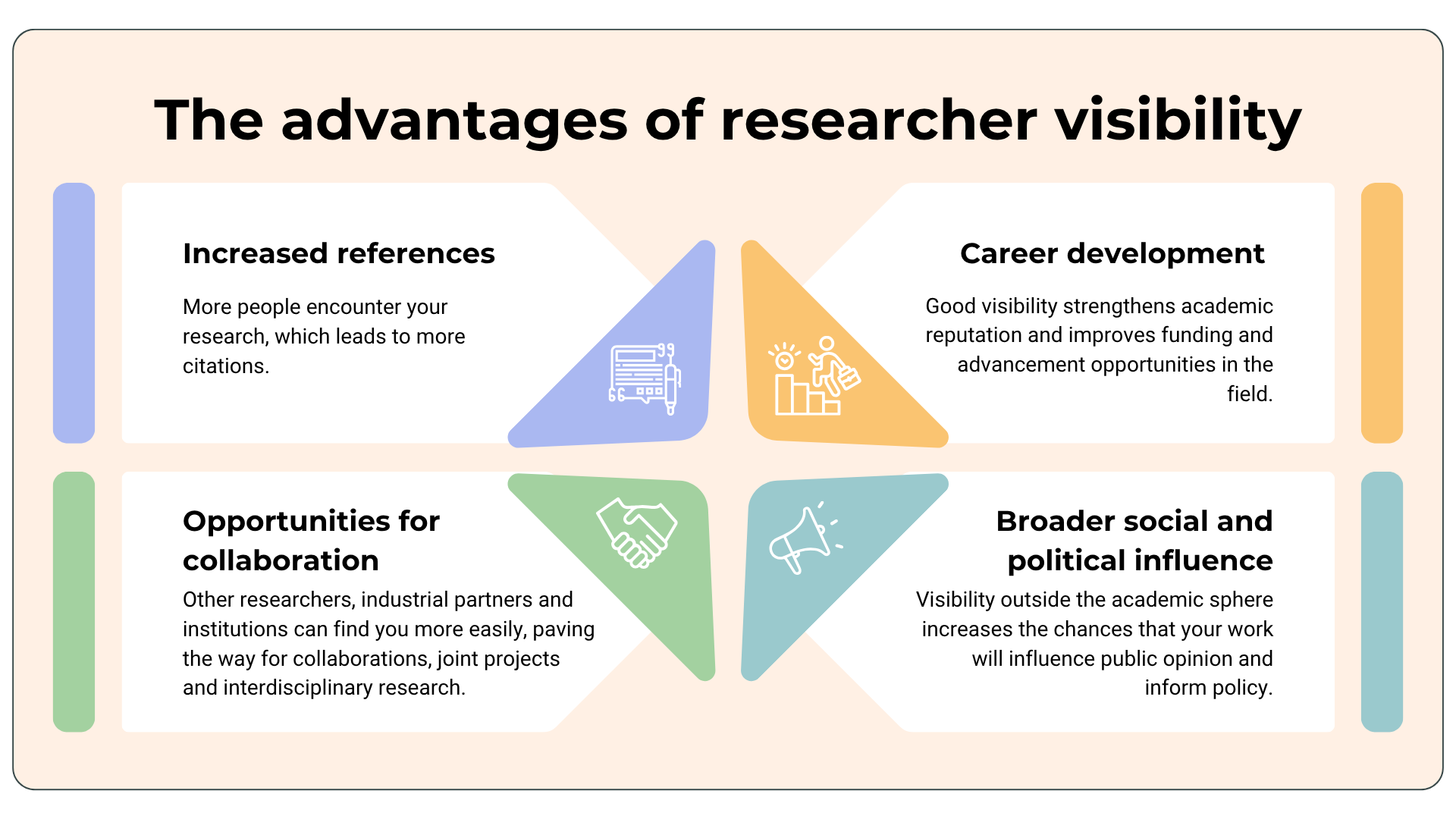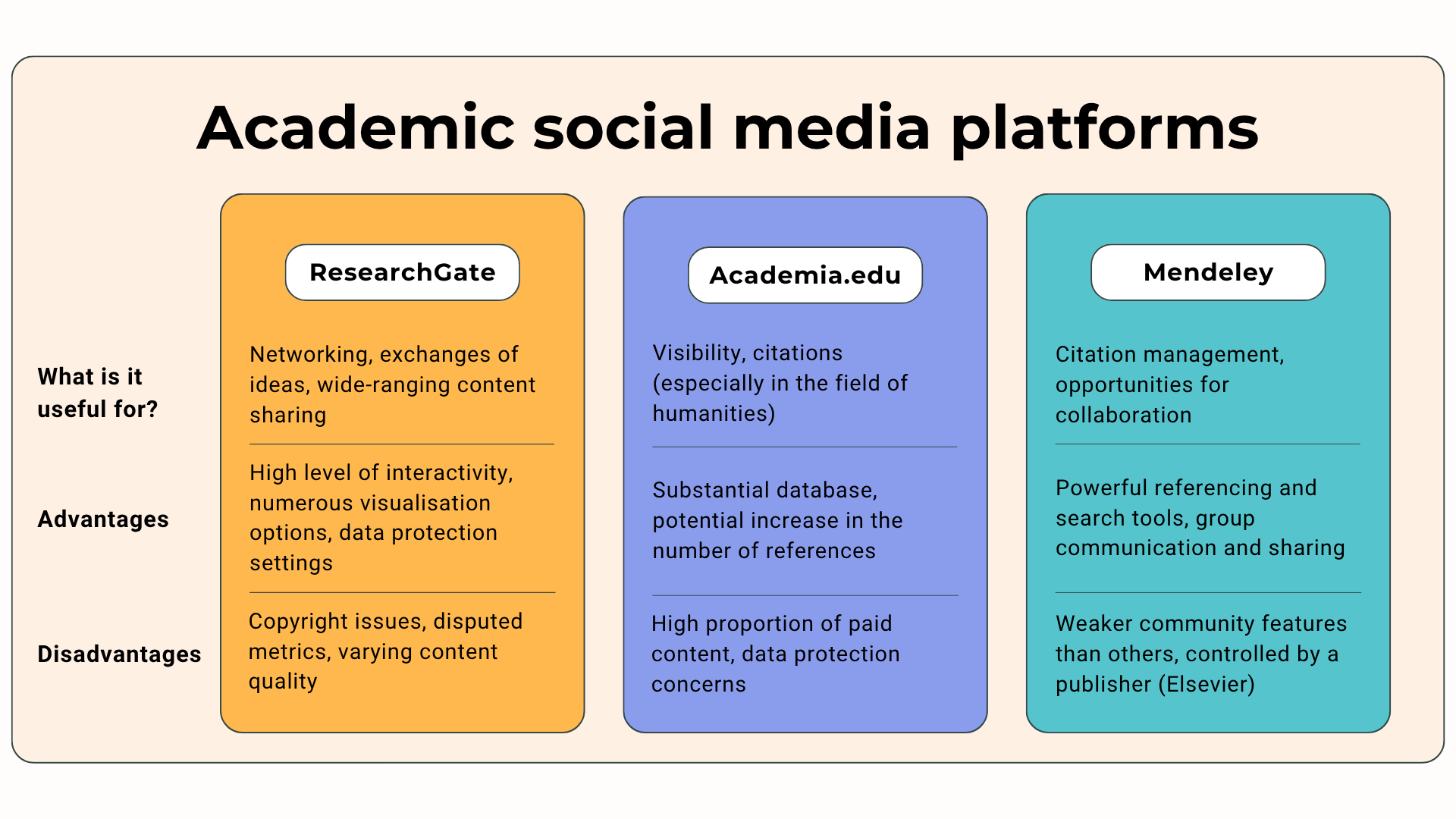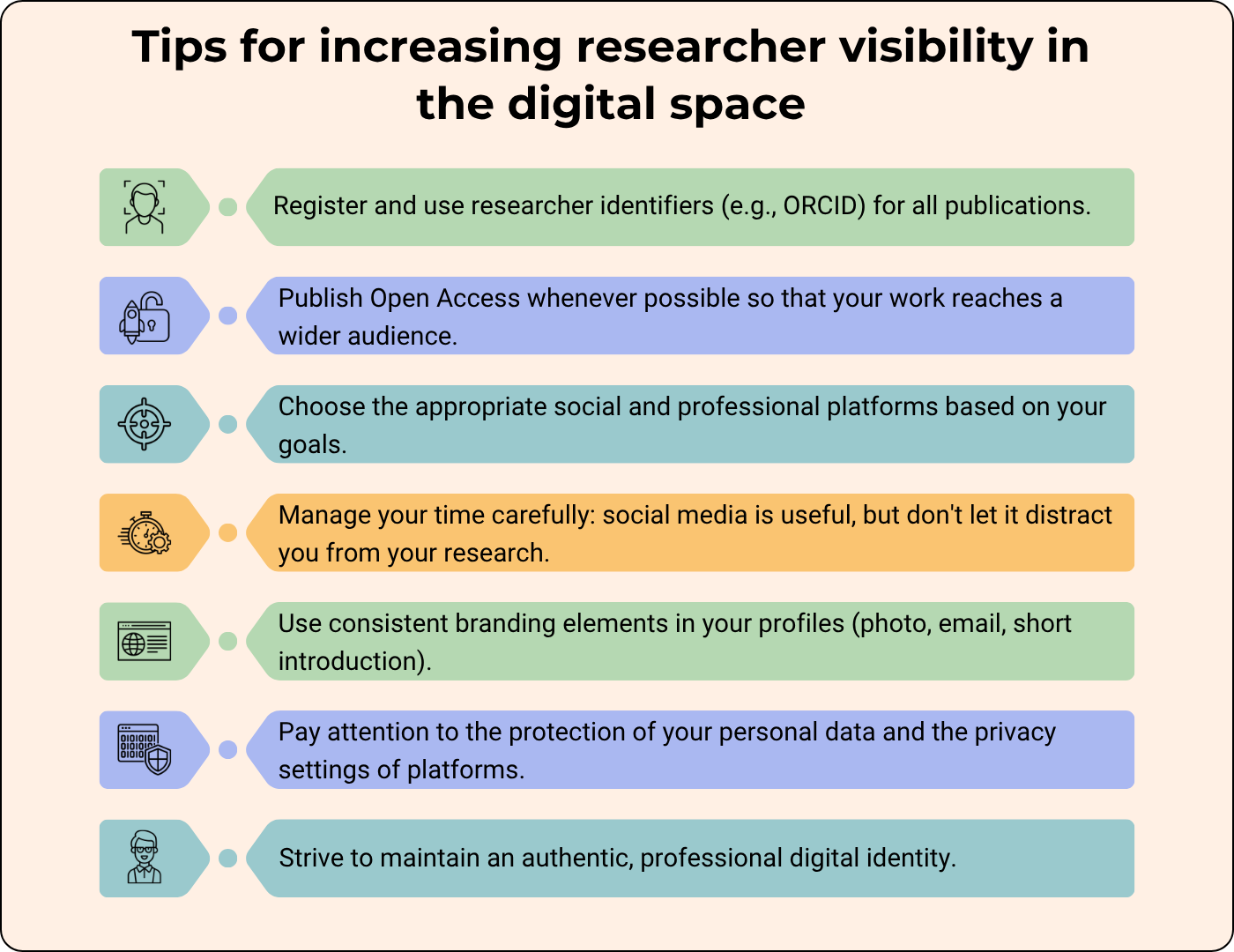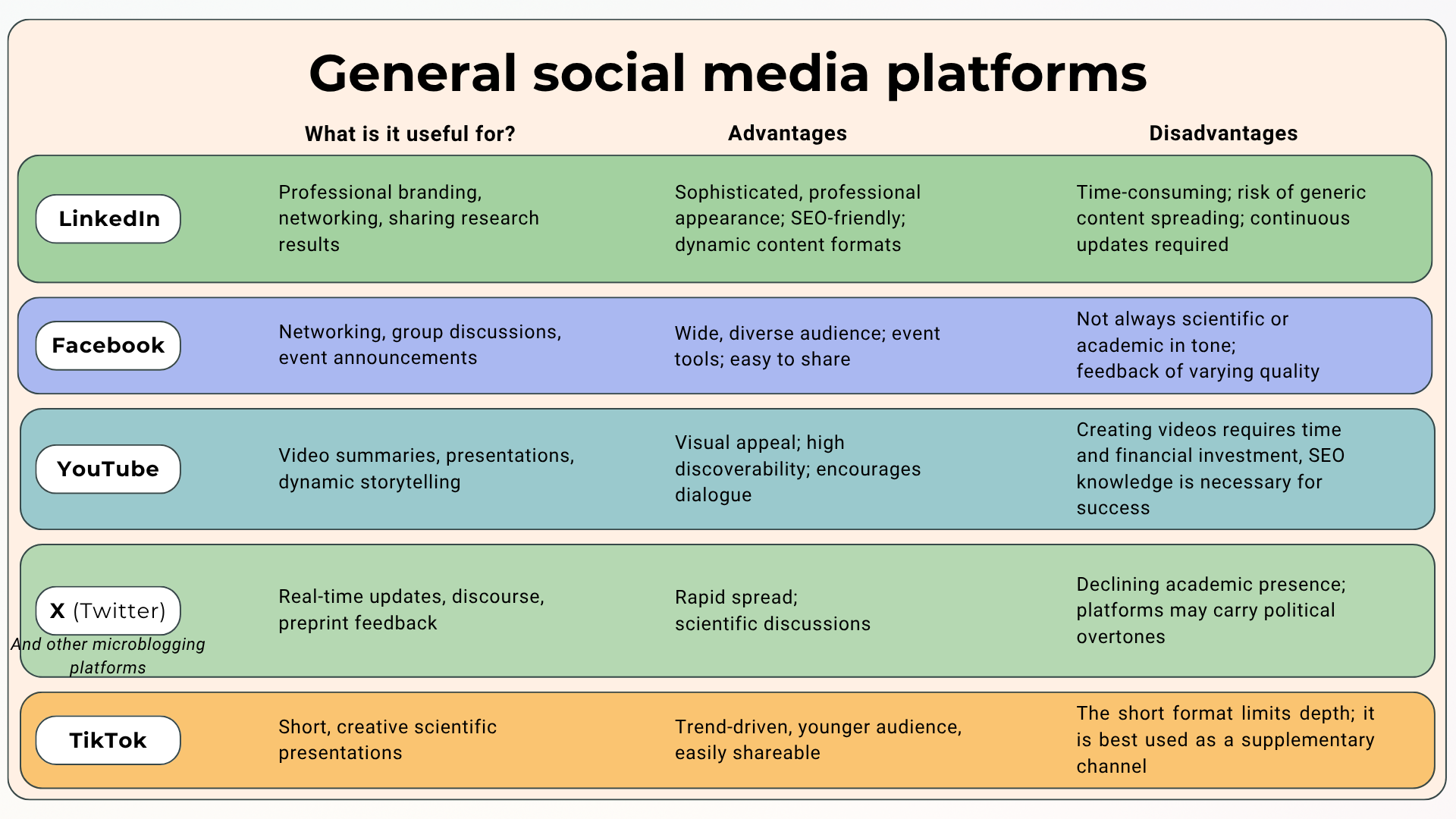In today’s academic world, it is not enough to simply be a good researcher – you also need to be visible. In this blog post, we explain what researcher visibility means in the digital space and what tools can help researchers establish it. We will discuss conscious online presence, building a digital identity, and strategies that researchers can use to strengthen their professional reputation in the long term.
The role of researcher visibility
Researcher visibility refers to how easily a researcher’s professional work and publications can be accessed, recognised and tracked by the scientific community and the wider public. In short, it is about how ‘visible’ a researcher is in the scientific sphere (and beyond).
In today’s scientific world, where research results spread quickly and often globally, visibility is not just a matter of personal prestige, but also a key factor in shaping a researcher’s career. Visibility not only increases the number of citations and potential collaborations but also helps researchers connect more easily to international scientific networks, funding opportunities and new research projects.
Researcher visibility is also a crucial factor for institutions: high-profile and recognised researchers naturally enhance the professional prestige of their university or research institute, improve its position in international rankings, and make the institution more attractive to both students and research partners. For this reason, consciously building researcher visibility is not only in the interest of the researcher, but also of the institution.

Before visibility: recognition
Before developing a visibility strategy, researchers must first ensure that they are recognisable and easily identifiable. Researcher IDs are designed to help achieve this goal.
Researcher IDs are unique digital identifiers designed to clearly and permanently link researchers to their publications, projects and institutional affiliations in the scientific community. Identifiers provide a solution to misunderstandings arising from name similarities and make it easy to track a researcher’s work even if they change their name. Hungarian researchers often encounter the problem that the journal or publisher they publish with cannot handle the special characters of the Hungarian alphabet. In such cases, a researcher identifier easily links the publication to the author’s other work, even if the name has been written in different ways.
Some of the more well-known researcher IDs include ResearcherID (associated with Web of Science), Scopus Author ID (tied to Elsevier’s database), and Google Scholar profile, which automatically collects and organises publications and citations. These are all useful tools, but as each is linked to a specific publisher or database ecosystem, they are not fully interchangeable. In addition, these profiles are created automatically when an author’s publication is included in each database, which can lead to duplication and incorrect data. We have written about managing these profiles before; our articles on cleaning up your Scopus profile and cleaning up your WoS profile can help you manage these profiles professionally.
In contrast, ORCID (Open Researcher and Contributor ID) is an independent, open and international standard that provides a 16-digit identifier for every registered researcher. ORCID is therefore a globally stable, standardised identifier that can be linked to other systems (such as grant portals or publishing platforms). Its advantages include that it is free to create, can be used in any field, and is based on an open infrastructure. In addition, researchers can decide for themselves which data is public and which is private, allowing flexibility. You can learn more about this identifier in our previous article.
This makes it clear that ORCID (and researcher identifiers in general) can bring about positive changes in the lives of researchers in several areas. They help with researcher visibility and the accurate identification of results, facilitate interoperability between different databases and systems, reduce unnecessary administration (e.g. when applying for grants or submitting publications), and, last but not least, they can be created and maintained free of charge. A well-maintained researcher identifier therefore not only increases scientific visibility, but can also reduce the administrative burden of everyday research work.
Open science for researcher visibility
Making researchers’ work openly available can greatly help to increase their visibility. Scientific articles published open access are freely available to anyone without subscription restrictions, and this openness directly contributes to increasing researchers’ visibility. This means that research results are not only available to larger universities or institutions with subscriptions, but also to smaller research centres, scientists in developing countries, and a wider professional and general audience.
Not only does open access ensure a wider readership, but it can also increase citations, as publications can spread more easily and be incorporated into scientific discourse quicker. The work of researchers can be more easily discovered not only by colleagues, but also by key practitioners, decision-makers, and journalists, which can strengthen professional reputation and promote social engagement.
We provide funding in several ways for researchers, lecturers, and PhD students at our university to publish their articles in open access. You can find out more about this here.
The role of social media in researcher visibility
Nowadays, social media platforms offer a unique opportunity to increase researcher visibility. Not only do they provide opportunities to expand professional networks, but they also allow researchers to share their results directly and reach a wider audience.
However, a conscious presence is essential for positive results: different platforms offer different opportunities, so it is worth considering which ones are right for us.
Academic community platforms
Academic social media platforms were created specifically for researchers and educators, so their primary goal is to connect researchers with each other and facilitate scientific communication. These platforms offer opportunities to share publications, participate in professional discussions, and establish new collaborations.
Although there are an increasing number of social media platforms serving this purpose, we will highlight three in this article:
- ResearchGate: the most widely used scientific social network, which allows users to upload publications, create researcher profiles and engage in professional discussions in a question-and-answer format. In addition to academics, it is also used by employers looking for researchers for their projects.
- Academia.edu: one of the largest academic social networks, allowing researchers to share their studies, create academic profiles, connect with others, and track the impact of their work. Certain features are only available with a premium subscription.
- Mendeley: this platform is not only used to manage scientific articles and references but also serves as a social network for researchers. Any registered user can create a profile, join research groups, and share materials.
These platforms can be particularly useful in increasing visibility, as researchers’ publications are easily and quickly accessible and interested parties can immediately contact the authors. However, it is important to note that these sites do not replace institutional repositories or official identifiers (e.g. ORCID), as they are complementary services and are therefore best used in conjunction with each other.
In the case of academic social media platforms, conscious use is key: it is worth uploading your most important works and actively responding to requests from other researchers.

General social media platforms
In addition to social media sites designed specifically for the academic community, more ‘general’ platforms can also be used to increase researcher visibility, as they provide both an opportunity to connect with the research community and a platform for reaching a broader social audience and communicating science.
If we want to address not only the academic community but also a wider audience on these websites, it is particularly important to pay attention not only to what we say, but also to how we say it. Unlike academic social media sites, it is advisable to use more accessible language on these platforms instead of technical jargon.
There are countless examples of these general social media platforms; we couldn’t possibly list them all, but here are a few examples.
- LinkedIn: A professional networking platform that bridges the gap between academic and more general platforms. Particularly useful for advertising job vacancies or opportunities, sharing publications and promoting professional events.
- Facebook: A much wider audience can be reached here than on academic platforms. It is a suitable platform for organising and promoting research groups and professional events. Closed groups offer a great opportunity to build relationships.
- YouTube: A video platform that can be used to present lectures and research projects in an accessible way. It is also well suited for broadcasting online conferences and science communication.
- TikTok: A platform designed for sharing short-form videos, which can help reach younger audiences, especially through short, creative educational content.
- X (previously: Twitter)/Bluesky/Mastodon/Threads: Microblogging platforms that are suitable for live streaming conferences and workshops or sharing research news. They enable rapid scientific communication and global networking.
- Personal website or blog: These platforms offer a unique opportunity for researchers to showcase their publications, projects and professional portfolios in one place. The creator of the website has complete control over the content, but these websites will initially have lower reach than social media platforms.
What strategy should you follow?
It is not necessary, nor is it worthwhile, to be present on every social media platform. A much more effective strategy is for researchers to choose platforms and forms of communication that are relevant to their field and professional goals, and to maintain a consistent presence on these.
Responsible presence in the digital space
As we have shown in this article, researchers can greatly benefit from their presence on online platforms and from increasing their visibility. However, these platforms not only offer opportunities, but also entail responsibilities: while various social and scientific platforms strengthen professional recognition, it is also important to pay attention to the protection of personal data and the maintenance of a credible digital identity.
Online platforms operate with different privacy settings and practices, so it is worth reviewing from time-to-time what information we share publicly. It is important to make conscious decisions about what information, such as our contact details, affiliations, or publications, should be accessible to everyone and what should be restricted to a smaller circle.
Maintaining a professional and credible digital identity is one of the most important pillars of researcher visibility in the long term. This includes creating a consistent and professional image, updating research results and affiliations, and separating professional and personal content. It is also worth consciously considering which platforms we are active on and what image we convey of ourselves there.
In addition, it is important to pay attention to our own security: disclosing too much personal information can lead to potential misuse. It is also important to remember that our digital footprint remains for a long time, so all shared content can affect how we are judged in the future.
Overall, digital presence is a great opportunity to increase researcher visibility, but it requires responsible and conscious use. Paying attention to data protection and establishing a professional, credible online identity not only strengthens the researcher’s own career but also contributes to maintaining trust in science.
If you have any questions on this topic, please contact our staff at authorsupport@lib.pte.hu.



